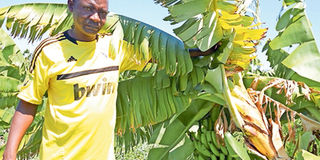A gamble with bananas after maize failure pays off for farmer

Mark Munuve in his banana plantation in Mrabaini, Taveta. The 40-year-old farmer grows the Grande Naine banana variety. PHOTO | DIANA MUTHEU | NMG
What you need to know:
- As many other residents, he was an ardent maize farmer but a stubborn weed known as African couch grass (Digitaria abyssinica), which locals call sangara, pushed him to the fruit.
- But the farmer recently found a lucrative market from Twiga Foods, a Nairobi-based firm that offers Sh16 per kilo, with his bananas averaging 50kg. Munuve harvests up to 30 bunches a month.
- Davis Mwangoma, the county executive in-charge of agriculture, says that with the help of the European Union, the county government of Taita-Taveta is putting up a Sh112 million banana processing plant in Taveta sub county.
- Moles are among the biggest enemies of banana plants, with the rats eating the crop from the ground leaving them to die
Some 8km from Taveta Town in Mrabani, the Seeds of Gold team meets Mark Munuve on his banana plantation.
The Njoro Kubwa canal channels water from Njoro River into the area that most farmers like Munuve use to irrigate their farms.
The 40-year-old farmer grows the Grande naine banana varieties, a venture that he has been doing since 2013. However, Munuve confesses that he did not begin as a banana farmer.
As many other residents, he was an ardent maize farmer but a stubborn weed known as African couch grass (Digitaria abyssinica), which locals call sangara, pushed him to the fruit.
“The weed would infest my maize making me harvest losses. I decided to try growing bananas. I planted 50 stems on the border of the farm and in the middle row. With time, I realised that the deadly weed did not attack the bananas," says Munuve.
And that was his turning point, with the farmer adding 150 stems of bananas on the one-and-half acre farm. Today, he is one the leading banana farmers in Mrabani.
"I plant the bananas by first digging holes that measure 90cm by 90cm by 60cm then I put in 20kg of animal manure.
MOLES' THREAT
I, thereafter, mix with the soil and then plant the banana stems," says Munuve, noting the bananas start fruiting at six months. His main markets for the produce are Nairobi and Mombasa, where traders come from to buy the produce.
"Initially, I would sell a bunch at Sh300 each when the market is good but sometimes brokers would offer even at Sh150,” he says, noting the money is little compared to his expenses as sometimes he has to buy pesticides to kill mites that attack the crop.
But the farmer recently found a lucrative market from Twiga Foods, a Nairobi-based firm that offers Sh16 per kilo, with his bananas averaging 50kg. Munuve harvests up to 30 bunches a month. “The county should consider setting up a banana factory in Taveta so that farmers can add value to their produce,” he offers.
“We are longing for the time when we will sell our produce at Sh30 to Sh40 per kilo.”
Davis Mwangoma, the county executive in-charge of agriculture, says that with the help of the European Union, the county government of Taita-Taveta is putting up a Sh112 million banana processing plant in Taveta sub county.
“It will take eight to 12 months to set up the banana processing factory. We expect the facility to boost banana production and improve the lives of farmers since they will earn more,” he said.
Moles are among the biggest enemies of banana plants, with the rats eating the crop from the ground leaving them to die. The most recommendable way to solve the problem permanently is by trapping the moles and killing them.
However, trapping is expensive, but it is the surest technique. There are rodenticides to control the rats while some farmers use pig urine, which also helps to keep them at aby.
Diseases to guard against include cigar end rot and banana bacterial wilt, which is another worst enemy of the crop.




